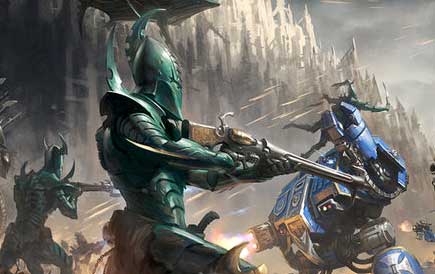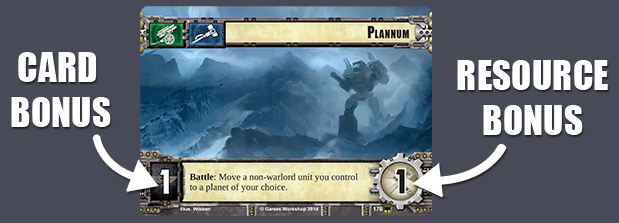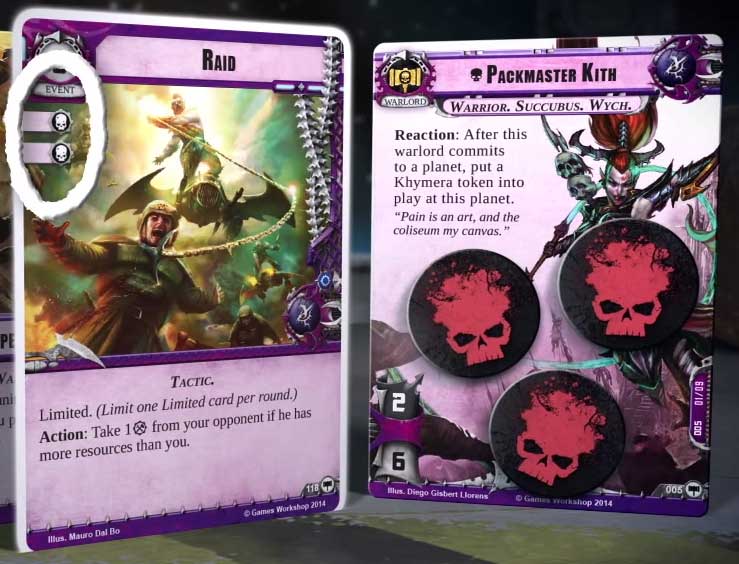Welcome to Card Game DB
Register now to gain access to all of our features. Once registered and logged in, you will be able to create topics, post replies to existing threads, give reputation to your fellow members, get your own private messenger, post status updates, manage your profile and so much more. If you already have an account, login here - otherwise create an account for free today!
Register now to gain access to all of our features. Once registered and logged in, you will be able to create topics, post replies to existing threads, give reputation to your fellow members, get your own private messenger, post status updates, manage your profile and so much more. If you already have an account, login here - otherwise create an account for free today!
Flooded No More
Oct 02 2014 03:35 AM |
SynnerG
in Warhammer 40k: Conquest
Warhammer 40K: Conquest Mechanics The War Room SynnerG Being flooded. That terrible feeling in a card game when your opening hand is awash with cards that are not doing anything for an opening play and may even lose you the game in the first few turns. But you put these cards in your deck, how could they betray you?! A careful balance is needed to make your deck work and fuel your plays or win you points. With Android: Netrunner, you include cards like Sure Gamble or Kati Jones to generate your economy or you can play Diesel to generate card draw. However, in breaking the mold of older card games, you can also spend your actions to take credits or cards if you don't draw either and you need to bide your time. This lets you be flexible and always have something to do with your turn to build up. This is what first drew me to the design and I loved it. However, some of the other LCGs have also handled this issue another way, and 40K: Conquest has captured it perfectly.
Being flooded. That terrible feeling in a card game when your opening hand is awash with cards that are not doing anything for an opening play and may even lose you the game in the first few turns. But you put these cards in your deck, how could they betray you?! A careful balance is needed to make your deck work and fuel your plays or win you points. With Android: Netrunner, you include cards like Sure Gamble or Kati Jones to generate your economy or you can play Diesel to generate card draw. However, in breaking the mold of older card games, you can also spend your actions to take credits or cards if you don't draw either and you need to bide your time. This lets you be flexible and always have something to do with your turn to build up. This is what first drew me to the design and I loved it. However, some of the other LCGs have also handled this issue another way, and 40K: Conquest has captured it perfectly.For those not familiar with the game, you begin the game with seven cards and seven resources. The main mechanic to gain any future cards or resources is called the “Command Struggle.†To win these command struggles, your army units have a range of “Command Icons†from 0 to 4, on average. Playing army units to each planet will give each player an idea of what the other wants to win. Planets have either just card draw, just resources, or both ranging from 0 to 2 in values. After committing your Warlord to a planet, you resolve the struggle by totaling the icons, and whoever has the most wins the draw and resources. Important caveats are that Warlords trump any number of icons and exhausted units to not contribute their icons.

You may need to play this game once or twice to see how this shatters the mold of deck building. Instead of including resource cards in the deck like the Lands or Sure Gamble, your army units are your resources. Through actively playing the game you are passively gaining card draw and resources. You’re not putting in cards that are exchanging themselves for more draw like “play to draw two cards.†Why dedicate deck space to cards that just to see more cards of your deck? I want to draw a card that is immediately usable. That is the goal of all deck building and this game captures that. You are also not dedicating actions to draw or gain resources. The game could have easily been designed so that during the deploy phase your action could be to draw a card instead of playing an army unit. This would just serve to slow the game and through the included mechanics, is unnecessary. Luckily that is not the case, as this game is brutal and fast paced. By deploying an army unit, you will be gaining what you need for the rest of the game, plus the card can defeat enemies and defend itself and provide actions. Fighting over the resources also plays into the theme. Commanders are sending their supporting units to planets and forcing the planets resources to the front lines for battle. But it also allows the other commander to send raiding parties and destroy the resource producers when they know their main force is strong enough to take the first planet on their own.
Another unique element of resource management in Conquest is that you are free to deploy as many cards and resources as you can in the Deploy Phase because an “all-in†approach isn't a gamble. One feeling that new players will experience and then overcome is the thought, “I need to save these cards and resources for next turn.†However, for each planet you take you gain their benefits of economy and card draw before combat starts, and will continue to do so as long as they hold the planet. This allows for you to be aggressive, be rewarded for it, and then still have options when combat starts with new cards and the resources to pay to use them.

The resolution of a round is the HQ Phase, or basically a cleanup check. Besides prepping the board for the next turn, each player draws two cards and gains four resources. This provides a base line or minimum that a player is guaranteed to receive, even if he isn’t able to capture a planet. This can still allow for a few low cost units to make it out or make game changing plays with the more powerful clear cards like Doom. The Doom event costs four, but could wipe out the enemy if his forces are in HQ, normally after being aggressive and claiming the first planet. Now you have a chance at catching up in unit numbers. Another play that is possible is using a Chaos card called Promise of Glory which is zero cost to play and puts two token Cultists into play at HQ. These units can be sacrificed to reduce the cost of Daemon units by one, each. You could burn both to call in a normally six cost unit for just four resources instead, like a formidable Soul Grinder which is useful for winning command struggles. This could establish a foothold on a planet and allow you to make your come back.
Finally, another aspect or common term of card games surrounding resource management is having a “dead draw.†This is usually a card that is for the early game and you've drawn it late, or it has a requirement to play that just doesn't seem obtainable in the current board state. I feel that is largely gone from this this game. Even if I draw my cost reducing building two turns away from the end of the game, it can still be played if the game state appears that it will go to the last planet to determine winner. That means you can still get an extra free resource and can delay your deployment to see what your enemy has planned. Another reason those cards are referred to as “dead†is that they clog up your hand, when more valuable cards could be taking their place. Well, Conquest has no hand size limit, so there’s no worry about not having space in hand, or for having to make decisions about what will be discarded to get down to your limit. Add in that events and attachments can be played as shield cards instead of their written ability, that just means an early game or situational event that will never fire off is now still usable and has utility. The Tau can utilize the dual use of cards the most if in a bad situation. I've had games where I only drew two army units, and the rest were attachments and events and I was able to use them for a mix of outmaneuvering tactics and shielding the unit to keep it from dying. In the meantime, my Warlord would go after the planets with the most card draw.

I’ll admit I’m no authority on the history of card gaming, but we live in the now! So with that and it's design, 40K: Conquest is the LCG of choice for me. I've always been frustrated with the card draw and flooding of other games. I could deck build and deck build, but you still have to include certain cards that are played at certain times and the game was a trial in mitigating those factors. Conquest allows for those worries and troubles to fall by the wayside and so that you may focus on the action. All cards are useful and if you are playing well towards the end game goal, you’re inherently drawing cards and gaining resources to play them. This streamlined approach is also varied, deep, and contributes to the design space of the future of the game. Stay tuned for a future piece that delves deeper into this subject.
I've also started a blog here called the War Room if you'd ever like to discuss these articles more: http://www.cardgamed...2-the-war-room/
- mischraum, snagga, alpha5099 and 4 others like this



 Sign In
Sign In Create Account
Create Account











5 Comments
Great opening article, SynnerG. The Command Struggle is just a beautiful piece of game design, and as most of us have noted time and again in our discussions of the game, it's extremely important.
For new players, that bears repeating: the Command Struggle is often just as important, and sometimes even more important, than combat. Low-cost units with one or two command icons will be among your most valuable units. Include a lot of them, and for most factions, always considering including Promotion.
This game really took a lot of notes from the well-developed and fleshed out ideas from other successful card games (Game of thrones, Call of Cthulu, Star Wars LCG) with notes taken form other products and took out the bad parts, kept the good, and splashed in the gritty and fun warhammer 40k genre.
I always said "Wouldn't it be cool if you deployed your units to the Star Wars LCG objectives instead of just having them openly fight - well here it is. Honestly I like this game even more than SW LCG. The developers did a friggin great job.
Begrudgingly tried this game tonight and I got hooked. I'll just play Space Marines and try to kill everything like a Stark.
Starkjoy, I did the same thing!
This is similar to SW CCG. ....and it's awesome.
....and it's awesome.